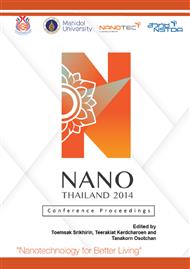p.88
p.97
p.106
p.110
p.117
p.123
p.131
p.135
p.139
The Photoluminescence Properties of the Alkali Metals Functionalized Adamantane Studied by Using Linear-Response Time-Dependent Density Functional Theory (TD-DFT) Calculations
Abstract:
The photoluminescence properties of pristine adamantane molecule have been calculated by time-dependent density functional theory (TD-DFT) within the hybrid functional level. This study aims to investigate the luminescence properties of the pristine adamantane molecule and its functionalized with neutral and ion of alkali metal to form C10H16-nXn structure (where X is Li, Li+, Na and Na+ atoms, n=1). The electronic gap of the pristine adamantane (7.15 eV) is too wide, leading to an insulator property. While all the functionalized adamantanes exhibit semiconducting behavior. The absorption and emission energies of the original structure are 6.51 eV and 5.63 eV, respectively which are in good agreement with experimental results. The pure adamantane exhibits a broad photoluminescence peak in the ultraviolet region (UV). The Stokes shift of the transition between vertical and emission is 0.88 eV which agrees well with the previous work that measures the Stokes shift of 0.7 eV. The modification of adamantane indicates that the absorption and emission gaps substantially decreases. Substituting with alkali metal causes the photoluminescence onset can be shifted from the UV to the near-IR region. These results suggest that pure and the alkali metal functionalized adamantane molecules are promoting as candidate materials for the opto-electronic applications in the ultraviolet to infrared spectral regions.
Info:
Periodical:
Pages:
117-122
Citation:
Online since:
December 2015
Keywords:
Price:
Сopyright:
© 2016 Trans Tech Publications Ltd. All Rights Reserved
Share:
Citation:


